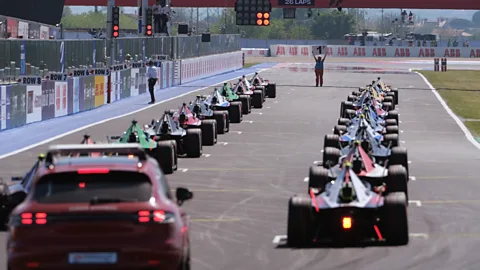Formula E: The world's fastest electric vehicles could spark widespread innovation

The common electric vehicle doesn't need to hit lightning speed – but Formula E race cars could usher in a new era for all.
When Formula E's Season 10 kicked off at Mexico City's Autodromo Hermanos Rodriguez in January, the roar of 40,000 spectators easily drowned out the mosquito whine of the 24 all-electric race cars zipping off the starting grid. Hurtling along at speeds upwards of 300km/h (186mph), some of the best drivers in the world jockeyed for position along the circuit.
Dreamed up in 2011 on the back of a napkin at a Paris restaurant, Formula E is now a decade old. It has 11 teams, with 22 drivers total, operating single-seater race cars similar in appearance to the famed open-cockpit vehicles of Formula One.
"The standard of driving is very high," says Graham Evans, director of auto supply chain and technology for S&P Global Mobility, an automotive intelligence firm. "These are very good guys who are also very experienced professional drivers."
Since its first season in 2014, Formula E has grown into a lucrative business. Intelligence company GlobalData estimates the championship's total sponsorship for the 2023-2024 season at $102.5m (£81.36m), with international viewership and attendance estimated at 344 million worldwide in 2023.
The batteries in the current generation of Formula E cars deliver up to 350kW of power, and can propel a driver to a maximum top speed of 320km/h (199mph), approaching the top speed of traditional F1 cars. And while the racing series may not have the pedigree – or budget – of F1, it does provide a unique and important testing ground for new battery technology that could benefit the entire EV industry.
 Getty Images
Getty Images'Sustained high performance'
The competition among engineering firms to design batteries for Formula E is fierce, says Ashley Nunes, an associate and researcher at Harvard University's department of economics, who studies the electric vehicle market. Only a handful of elite companies can build these batteries to the specifications required to compete in a world-renowned race.
The companies who've won bids include WAE, McLaren, Podium Advanced Technologies and Atieva, the technology arm of luxury EV brand Lucid Motors. Most of these companies already have a pedigree of building high-performance tech, including batteries, for the biggest internal combustion engine (ICE)-powered racing series in the world, Formula 1. While designing this technology may bring in more revenue for these companies in the short term, there's plenty of money to be made in engineering battery technology for Formula E.
The technology is far more expensive than the batteries found in a typical road EV, and for good reason. A Tesla Model S going all-out on a racetrack will start slowing down as the battery charge gets depleted, says Evans. That's because the battery isn't capable of handling sustained race performance. By contrast, any petrol or diesel-powered car can stay at top speed even on a quarter of a tank. A Formula E battery needs to behave more like its ICE kin at all times. "It's got to deliver sustained high performance," says Evans.
On top of offering enough power for incredible bursts of speed, a Formula E battery needs to remain as light as possible. Race regulations require it to weigh just 284kg (626lbs), roughly a third of the car's total weight including the driver, and be capable of ultra-fast charging during a race. Plus, batteries get hot when overused, so they need an elaborate cooling system. All those requirements create tremendous engineering challenges (and capital requirements) for whichever company is tapped to build a Formula E battery.
 Getty Images
Getty Images"The margins are probably relatively small, but because there aren't many producers, you can charge a premium for them," says Evans. According to the Fédération Internationale De L'Automobile (Fia) – the regulatory body for both Formula 1 and Formula E – the GEN3 battery system's total cost for Formula E's 2022-2023 season was €264,812 ($268,000; £226,442). "The people who are paying that price are multi-billion-dollar companies like Mercedes and Ferrari," says Nunes." They have deep pockets."
From the track to the motorway
Formula E battery suppliers don't just earn money from the batteries themselves. The process of developing new battery pack configurations, cooling systems and fast-recharge techniques can all be patented. If a Formula E supplier creates a revolutionary new technology for the track, says Evans, and licenses it to a mainstream EV automaker building millions of units a year, the licensing fee alone could be well worth the investment.
More like this:
Plenty of innovations for everyday cars, like tire pressure gauges, had their origins in F1. But Nunes points out that the battery requirements for road EVs are very different from their ultra-competitive cousins. Drivers want high range, large capacity and longevity that simply aren't necessary for Formula E, whose batteries don't need to last for a decade or more of driving.
Experts are already watching some new battery developments. One is fast charging. Formula E vehicles use ultra-fast DC charging to reach top speeds, while passenger EV's use a slower AC charge that provides greater range. Still, many automakers in the commercial EV industry are keen to gain insight into Formula E charging technology as it rapidly evolves.
To Evans, the biggest innovation might come through immersion cooling, a system where Formula E batteries are immersed in a refrigerant called dielectric fluid. The result is a significantly cooler battery capable of long-lasting high performance. Combined with ultra-fast charging, he says the racetrack can serve as an incubator for EV development overall.
"In terms of being able to deliver that really high-powered challenge, Formula E can help us understand the art of the possible," says Evans.
--
If you liked this story, sign up for The Essential List newsletter – a handpicked selection of features, videos and can't-miss news, delivered to your inbox twice a week.
